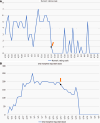Percutaneous cervical cordotomy for managing refractory pain in a patient with a Pancoast tumor: A case report
- PMID: 39070833
- PMCID: PMC11235500
- DOI: 10.12998/wjcc.v12.i21.4770
Percutaneous cervical cordotomy for managing refractory pain in a patient with a Pancoast tumor: A case report
Abstract
Background: According to the World Health Organization analgesic ladder, cancer-related pain generally begins with pharmacotherapy in a stepwise approach. Nevertheless, some patients continue to experience poorly controlled pain despite medications, particularly when considering adverse effects and self-care quality. Percutaneous cervical cordotomy is an alternative interventional procedure for unremitting unilateral intractable cancer-related pain.
Case summary: The patient was diagnosed with lung cancer with destruction of the brachial plexus and ribs. For 2 mo, the patient experienced progressive severe weakness and pain in the right upper extremity. Notably, the pain intensity reached an extreme level, particularly when lying supine, even under heavy sedation. This heightened pain response posed a significant challenge; as a result, the patient was unable to undergo further evaluation through magnetic resonance imaging. Ultimately, he underwent percutaneous cervical cordotomy for symptom relief, resulting in complete resolution of right arm pain. After a 3-mo follow-up, the pain did not recur, and only a flurbiprofen local patch was required for mild scapular tightness.
Conclusion: Cordotomy, under careful patient selection, appears to enhance the quality of life of patients with unilateral cancer-related pain.
Keywords: Cancer pain; Case report; Cordotomy; Fluoroscopy; Intractable pain; Radiofrequency therapy.
©The Author(s) 2024. Published by Baishideng Publishing Group Inc. All rights reserved.
Conflict of interest statement
Conflict-of-interest statement: The authors have no conflicts of interest to declare.
Figures





References
-
- Javed S, Viswanathan A, Abdi S. Cordotomy for Intractable Cancer Pain: A Narrative Review. Pain Physician. 2020;23:283–292. - PubMed
-
- Spiller WG, Martin E. The treatment of persistent pain of organic origin in the lower part of the body by division of the anterolateral column of the spinal cord. JAMA. 1912;58:1489–1490.
-
- Mullan S, Harper PV, Hekmatpanah J, Torres H, Dobbin G. Percutaneous Interruption of Spinal-Pain Tracts by Means of a Strontium90 Needle. J Neurosurg. 1963;20:931–939. - PubMed
-
- Winn HR. Neurosurgical Management of Intractable Pain. In: Mirzadeh Z, Rosenberg WS, Ben-Haim S, Follett KA. Youmans & Winn Neurological Surgery. 8th ed. Elsevier, 2023: chap 201.
-
- Massire A, Taso M, Besson P, Guye M, Ranjeva JP, Callot V. High-resolution multi-parametric quantitative magnetic resonance imaging of the human cervical spinal cord at 7T. Neuroimage. 2016;143:58–69. - PubMed
Publication types
LinkOut - more resources
Full Text Sources

